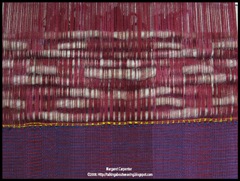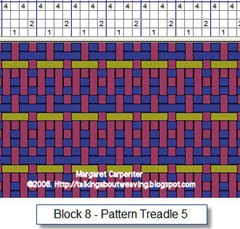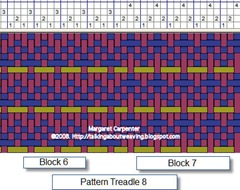Posted by Peg in South Carolina
To make it a bit easier to see ![End of warp samplingannotated watermarked_thumb[1] End of warp samplingannotated watermarked_thumb[1]](http://lh6.ggpht.com/weavingpeg/SO_E8VuFcqI/AAAAAAAABLQ/VHkDrPHIfX0/Endofwarpsamplingannotatedwatermarke%5B1%5D.jpg?imgmax=800) what is going on, I have included a photo with blocks and some of the pattern treadles labeled. At the top I have numbered the blocks (omitting even numbered ones for clarity). On the side I have labeled the pattern shaft used for the color in each group of blocks.The colors on the photo on yesterday’s blog post are better, but this photo might help with understanding.
what is going on, I have included a photo with blocks and some of the pattern treadles labeled. At the top I have numbered the blocks (omitting even numbered ones for clarity). On the side I have labeled the pattern shaft used for the color in each group of blocks.The colors on the photo on yesterday’s blog post are better, but this photo might help with understanding.
Also, forget the Snagit watermark in the lower right hand corner. I was fiddling with watermarks in that program and accidentally incorporated their watermark onto my image.
The second time I used blue on pattern shaft 5 I doubled it and it is a bit clearer. Actually it is clearer in the photo than it is in real time. Just beneath it where I treadled blue on pattern shaft 8, the blue is clearly visible in blocks 7. Huh?
Curious as to why using blue on pattern shaft 5 does not result in a clear effect of blue whereas it does on other pattern shafts, I decided to look at the drawdown. And here is what I found.
The lime represents the pattern color. Look at the drawdown for block 8 on the left. Here I am treadling treadles 3,4, and 6-8 with blue. Treadle 5 is the pattern treadle; and I threw a shot of lime weft on that treadle. The lime float over 3 threads. This is as it should be. But looking at the shot immediately above the lime (treadle 4), shows a blue weft float of 3. It is not directly over, true, but still…. That blue weft float has an effect, seen only in the actual woven fabric, on the pattern float beneath it.
Look at the drawdown on the right for block 7. Here the background treadles are 3-7; the pattern treadle is 8. When treadle 8 is woven with the lime it shows the 3-thread floats thread in the lime. But the blue 3-thread float that happens in the drawdown on the left where treadle 5 is the pattern treadle,does not happen here, either directly above or directly below the lime. Look again at the the drawdown on the right, but look at block 6 instead of 7. Unlike block 7, block 6 does have a blue weft float immediately preceding the pattern lime float. And, looking at the fabric, when the background weft is red and the pattern weft is dark blue, that pattern weft is virtually invisible.
So I conclude that the background weft threads contiguous to the pattern threads can, if the pattern threads are not bright enough, have a dulling effect on the pattern threads because of the tiny bit of slippage that happens between neighboring weft threads. I have always been aware of this slippage when weaving this fabric because I can clearly see that weft ends do not pack down levelly.
This irregular packing down is dramatically visible when I use  rug weft to separate samples as I did on the left. There the desire of wefts to move a bit over previous wefts is clear. When I first did this I thought, what the…….? But because the slippage changes with each treadle, everything evens out after all 6 treadles have been treadled. And the appearance is of an evenly beaten fabric.
rug weft to separate samples as I did on the left. There the desire of wefts to move a bit over previous wefts is clear. When I first did this I thought, what the…….? But because the slippage changes with each treadle, everything evens out after all 6 treadles have been treadled. And the appearance is of an evenly beaten fabric.
Now I am wondering if I can change the threading of blocks with two consecutive weft floats so that there is a weft float on only one treadle?
"More on End of Warp Sampling" was written by Margaret Carpenter for Talking about Weaving and was originally posted on October 10, 2008. © 2008 Margaret Carpenter aka Peg in South Carolina





2 comments:
Interesting observations. To me, this type of exploration is the joy of weaving. So, are you going to try to change the block threading as you suggest????
Leigh, right now I am so tired of working on my last two blog posts that the notion of doing anything more with drafts is totally unappealing...... But yes, after my weekend break from all of this, on Monday I hope to have my spirits back and start playing with the threading.
Post a Comment